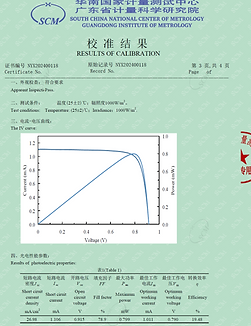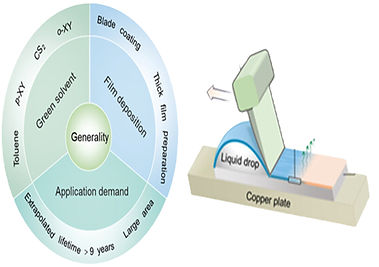I. Emerging Electronic Materials and Devices
Over the past decades, semiconducting polymers and small molecules have exhibited remarkable advancements, particularly in the realm of organic light-emitting devices (OLEDs), which have significantly transformed and dominated the light display market. These innovations have subsequently spurred the development of organic solar cells (OSCs), which utilize a device architecture akin to that of OLEDs. Despite this similarity, the molecular design of the photoactive components in OSCs is distinct from those in OLEDs and offers a virtually limitless array of modifications to the structure of these polymers and small molecules—an advantage that holds considerable promise. Nevertheless, the full potential of these materials remains unrealized due to the lack of a comprehensive understanding of the correlations between structure, property, and function. This knowledge gap continues to pose a challenge in optimizing and fully harnessing the capabilities of semiconducting polymers and small molecules within OSCs.
Perovskites and other solution-processable materials, similar to polymers and small molecules, could be the key to more affordable and efficient solar cells in the future. Unlike traditional methods used for other inorganic solar cells—which are typically energy-intensive and have a high carbon footprint—solution-based processes enable roll-to-roll and other printing techniques, making manufacturing simpler and more cost-effective. Therefore, creating strategies to enhance device efficiency, ensure long-term stability, and facilitate the transition from lab-scale to industrial-scale production is likely to yield substantial commercial benefits.
Sample Publications:
(1) Gao, W.,* Ma, R.,* Dela Peña, T.A.* et al. Efficient all-small-molecule organic solar cells processed with non-halogen solvent. Nature Communications 15, 1946 (2024).
(2) Zou, B.,* Wu, W.,* Dela Peña, T.A.* et al. Step-by-Step Modulation of Crystalline Features and Exciton Kinetics for 19.2% Efficiency Ortho-Xylene Processed Organic Solar Cells. Nano-Micro Lett. 16, 30 (2024).
II. Charge Carriers Mechanisms
In semiconductor devices, grasping the intricacies of charge carrier processes is crucial for establishing design principles that aid in developing new materials or improving existing fabrication techniques. To explore the dynamics of charge carriers, a range of spectroscopy tools is available, capable of examining timescales from femtoseconds to microseconds, depending on the speed of the process under study. Additionally, steady-state optical and electronic characterizations offer valuable and complementary insights.
Sample Publications:
(1) Dela Peña, T. A.* et al. Interface property–functionality interplay suppresses bimolecular recombination facilitating above 18% efficiency organic solar cells embracing simplistic fabrication. Energy & Environmental Science, 16(8), 3416-3429 (2023).
(2) Dela Peña, T. A.* et al. Understanding the charge transfer state and energy loss trade-offs in non-fullerene-based organic solar cells. ACS Energy Letters, 6(10), 3408-3416 (2021).
(3) Dela Peña, T. A.* et al. Manipulating the Charge Carriers Through Functionally Bridged Components Advances Low-Cost Organic Solar Cells with Green Solvent Processing. Adv. Energy Mater. 2024, 14, 2303169.
III. Nano/Micro-Structures and Morphology
Building nanostructures all the way up to macrostructures necessitates careful morphological analysis to optimize synthesis or fabrication processes. For materials with nano- and micro-structures, sensitive and non-destructive morphological characterization techniques are essential. These tools include surface scanning probes as well as more advanced methods like diffraction and x-ray scattering.
Sample Publications:
(1) W. Wu,* Y. Luo,* T. A. Dela Peña* et al. Defining Solid Additive's Pivotal Role on Morphology Regulation in Organic Solar Cells Produced by Layer-by-layer Deposition. Adv. Energy Mater. 2024, 14, 2400354.
(2) Dela Peña, T. A.* et al. Effects of Vertical Molecular Stratifications and Microstructures on the Properties of Fullerene-Free Organic Solar Cells. Adv. Photonics Res., 3: 2100339 (2022).
IV. Photocatalysis
In addition to solar cells, solar energy can be utilized for water splitting, a process that converts water molecules into hydrogen and oxygen gases through oxidation and reduction reactions. Hydrogen gas produced in this way is regarded as an alternative renewable energy source. To enhance the efficiency of these reactions, anodes and cathodes are modified with catalysts. Catalysts reduce the activation energy required, allowing the same amount of absorbed solar radiation to produce a greater volume of hydrogen gas.
Sample Publications:
(1) Kim, S., Dela Peña, T. A. et al. Co-catalytic effects of Bi-based metal-organic framework on BiVO4 photoanodes for photoelectrochemical water oxidation. Applied Surface Science, 563, 150357 (2021).
V. Sustainable Materials and Technologies
Transitioning lab-developed materials to commercial use is vital for impactful research but involves challenges beyond fundamental science, including environmental sustainability, industrial viability, and economics. For instance, scaling up solution-based solar cells requires halogen-free solvents and large-area printing instead of halogenated solvents and spin-coating. Additionally, assessing environmental risks related to material composition and the nature of intended application is often overlooked. The selection of emerging materials should prioritize not only performance but also the reduction of potential hazards to human health and the environment.
Sample Publications:
(1) B. Liu, ... , Dela Peña, T. A. et al. Isomerized Green Solid Additive Engineering for Thermally Stable and Eco-Friendly All-Polymer Solar Cells with Approaching 19% Efficiency. Adv. Mater. 2023, 35, 2308334.
(2) T. Jia, ... , Dela Peña, T. A. et al. Naphtho[1,2-c:5,6-c′]bis([1,2,3]thiadiazole) enables the design of efficient halogen-free polymer donors and fabrication of organic solar cells with >19% efficiency. Energy Environ. Sci., 2024,17, 8593-8608.






